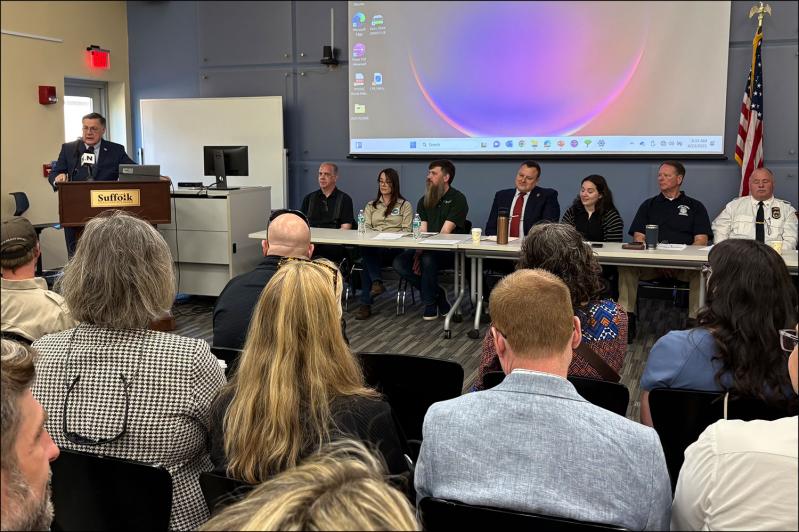Suffolk County Executive Ed Romaine called it an “aha moment” — an awakening after the Westhampton Pines fire on March 14. He’d had enough of the devastation caused by the southern pine beetle across the county he leads, and he wanted to do something about it.
So Mr. Romaine convened a symposium on April 23 to share the new science-based steps the county is taking to fight the beetle battle, as well as to cultivate awareness and address questions from the public. For three hours, a standing-room-only crowd packed into a conference room at Suffolk Community College’s Riverhead campus to hear from a who’s-who panel of more than a dozen experts and professionals in the areas of forest management, parks maintenance, public safety, and emergency response.
“What we’re seeing of the southern pine beetle is the result of climate change,” Mr. Romaine said in his opening remarks, to which the audience responded with an audible murmur of “hmms” and “wows.” “You can debate it, you can say it’s from all different causes, but the bottom line is, there’s climate change taking place. Forget the debate. Now we have to figure out what we can do to address it.”
From the forestry perspective, the mass cutting of infected trees is no longer the primary mitigation strategy, experts said at the symposium. Instead, tens of thousands of felled trees later, crews from New York State and Suffolk County are now carrying out strategic thinning of extremely dense pitch-pine forests so that air moves more freely through them. This airflow disrupts the pheromones that the pine beetles release as a callout to others — a sort of “Hey guys, I’m over here” that leads to large infestations capable of killing a healthy stand of trees within weeks.
“We are essentially disrupting their communication,” said Jess Cancelliere, a forest health coordinator with the State Department of Environmental Conservation. “In a closed-canopy forest, those pheromones sit there for a long time and help the beetles coordinate these massive attacks. When you open up the canopy, these pheromones dissipate and the beetles are left with no way to communicate.” This leads to a “decrease in pressure and number of acres of damage.”
According to Ms. Cancelliere, pine beetle outbreaks would cover an area 10 times larger without this suppression method. She specifically advised against the use of pesticides — even emamectin benzoate, a “somewhat effective” pesticide that can ward off the pine beetle to a degree.
“There are systemic injections available,” Ms. Cancelliere said. “This is going to be for a high-value street tree or yard tree that you want to preserve that you’re willing to dump money into in the long term. But if the tree has already been attacked, it is too late, these chemicals are not going to work.”
The most severe pine beetle infestations are now on Napeague and in the Central Pine Barrens, she said, but individual homeowners are still struggling with the problem, too.
“When it first arrived, we dealt with a lot of homeowners that had one or two pitch pines in their yard to 15 or 16 that died seemingly overnight,” Ms. Cancelliere said. “Tree removal costs are high — it’s a very hard thing to deal with. They are highly hazardous and difficult to remove. We always suggest you get professional help. It’s expensive, but you need an expert.”
Enter professionals like Rick Ely, a tree removal expert originally from East Hampton and now based in Eastport with 43 years in the business. But even he is facing difficulties. He spoke up at the symposium about attempting to bid on tree work on county land, particularly the removal of the dead felled trees, but said he hit too many obstacles.
“I couldn’t get this fellow to call me back, to give me a walk-through, to know what I could and couldn’t use in the woods,” Mr. Ely said. “It was frustrating. Here lies the problem. If a contractor wants to do the work . . . it’s not a good bidding system.”
Mr. Ely also pointed out the huge cost to homeowners who do want to remove trees that had been cut down by town or county crews. “There has to be some sort of relief,” he said. “These people can’t afford this.”
He also described a need to educate homeowners. “Most people are being told that a green giant is what you plant in the woods,” which should not be the case, he said.
Ms. Cancelliere addressed another level of confusion. “There is this message out there that once a tree dies it can’t be removed or disposed of because it will spread the beetle. I don’t think that’s true,” she said. The D.E.C.’s rules on the transport of wood mostly concern firewood, not the trees taken down because of pine beetle activity.
“There is some risk that if you’re disposing of your dead trees that a few beetles might emerge here and there,” she said, “but their resources are depleted. They’ll end up flying around until they run out of energy and die, so the risk is very low. You shouldn’t be worried about spreading the beetle by removing the dead trees.”
From the audience, Andy Drake, a senior environmental analyst in East Hampton Town’s Department of Land Acquisition and Management, spoke up. “Everything has shifted from suppression to management. We’re working on that as a town,” he said.
Then he asked a question that caused another murmur in the crowd — one that spoke to the risk of wildfires, which had been addressed at length by emergency response experts earlier in the symposium. “Those Westhampton fires, it was my understanding that was a living forest that was affected and not a southern pine beetle-affected forest with Stage 3 dead trees,” Mr. Drake said. “Can we just get confirmation of that and also if there have been any significant wildfires caused by dead, slashed material on the ground by the southern pine beetle in Suffolk County?”
Ms. Cancelliere responded. “We can confirm that was a living forest. There was no southern pine beetle in that area. It was mostly dwarf pines. We can’t confirm wildfires caused by the southern pine beetle.”




